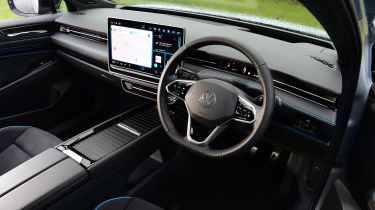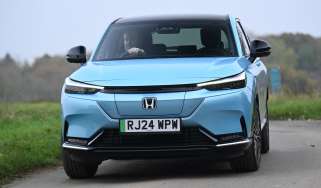Volkswagen ID.7 - Interior, design & technology
The design is hardly daring, but the car’s slippery shape boosts efficiency, and there are ergonomic improvements over past VW EVs

The Volkswagen ID.7 differs from the Tesla Model 3 and Hyundai Ioniq 6, in that while it resembles a similar saloon design, the ID.7 is a hatchback, much like the BMW i4.
That more practical bodystyle doesn’t hurt its aerodynamic efficiency, though, because the ID.7 has an impressively low drag coefficient of 0.25, which is very handy for giving it additional electric range over bulkier electric SUVs.
You have a choice of six colours with the ID.7, and four of those – Stonewashed Blue, Scale Silver, Glacier White and Aquamarine Blue – can be specified with a contrasting black roof. None of them are quite as bright as the colours available on the BMW i4 or Tesla Model 3, but at least you won’t be hit with a hefty bill (between £1,300 - £2,000 in the case of the Model 3) if you want metallic paint on your ID.7.
What is the Volkswagen ID.7 like inside?
It’s all quite smart inside the ID.7, but don’t expect any bright colour choices because the palette is a sombre one. If you want something beyond black, grey and silver, you’ll have to make use of the 30-colour ambient interior lighting system.
The main controls are a little confusing at first – the wipers are embedded on a stalk to the left of the steering wheel, rather than the right, for example – but at least they’re not buried within the touchscreen, and you still get indicators on a stalk, unlike on the Tesla.
One thing that is now lost within the screen is the adjustment of the central air-vent controls. As has been the case for decades now, you had simple manual controls to direct the airflow, but VW has followed Tesla's example of automating this adjustment and sticking it within the screen. In our view, it makes what was once an easy adjustment needlessly complicated.
What is the interior quality like?
Let’s first address the elephant(s) in the room. Volkswagen’s early ID cars came under heavy criticism for their lacklustre interior quality, plus fundamental failings in their technology and infotainment. With the ID.7, the maker is looking to right those wrongs.
Indeed, from the driver’s seat, all appears well. The general cabin ambience has been lifted to a level that easily competes with cars in this class; there are soft-touch materials on the doors and dash, and the seats offer plenty of support.
Sat-nav, stereo and infotainment
The Volkswagen ID.7’s big, bright, 15-inch central display instantly feels more responsive than in the maker’s previous electric offerings. The menu layout still has some controls buried deep within sub-menus, but at least the large screen in the ID.7 allows some frequently used functions to be on permanent display, such as the climate controls at the bottom of the screen.
Volkswagen has deemed it appropriate to backlight the adjustment sliders for the climate temperature and audio volume settings found at the base of the screen, so you can now find them at night. They’re still touch-sensitive, which means they’re not as easy to adjust on the move as the physical climate controls of the Hyundai Ioniq 6. Overall, we still prefer the BMW i4’s clickwheel design because it makes controlling an infotainment system much easier while on the move.
Wireless smartphone connectivity and a wireless phone charging pad are standard. All ID.7s come with a nine-speaker audio system with DAB radio, but you’ll need to pay for the pricey £2,000 Interior Pack to get the upgraded 12-speaker, 700-watt Harman Kardon sound system.










